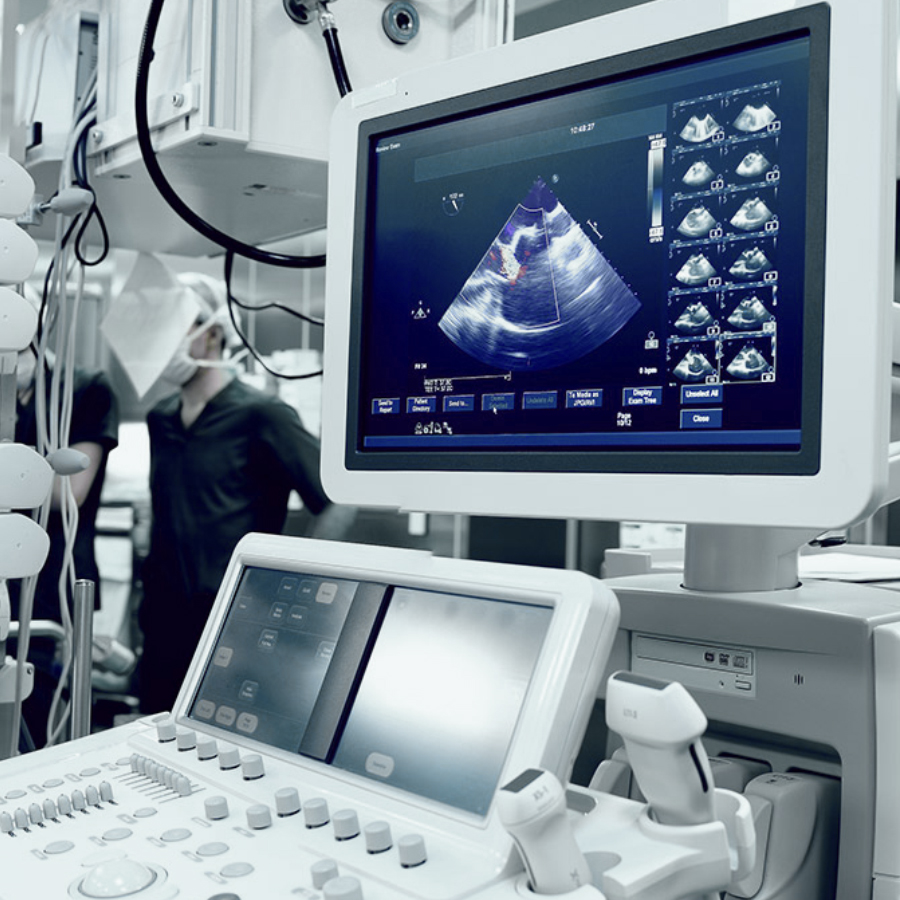ProMed, LLC
ProMED Solutions
Designed for Clinicians by Clinicians.

Medical solutions
Autonomic Nervous System Testing
More than 100 million U.S. adults are now living with diabetes or prediabetes, according to the Centers for Disease Control and Prevention (CDC). As of 2015, 30.3 million Americans – 9.4 percent of the U.S. population – have diabetes. Another 84.1 million have prediabetes, a condition that if not treated often leads to type 2 diabetes within five years.
Early detection of cardiovascular and peripheral neuropathies is key to managing diabetic patient populations. We are proud to offer leading-edge Autonomic Nervous System testing solutions that enable physicians to detect and manage ANS conditions. Our equipment measures galvanic skin response and Heart Rate Variability through a simple, quick, and non-invasive test that gives providers the ability to detect neuropathy before it becomes symptomatic.
Peripheral and cardiovascular neuropathy are among the largest concerns for diabetic patients, and it has been repeatedly proven that the earlier this condition can be detected and treated, the more likely a patient is to live a long and healthy life. Current estimates put the likelihood that a diabetic patient showing physical symptoms of peripheral neuropathy will survive through the next five years at between only 25 and 50 percent. By catching this condition through regular testing, health care providers can make a positive difference.
Autonomic Nervous System testing requires only minutes to set up and operate – the benefits for your patients last a lifetime. Also, with insurance billing codes that work with major private insurance, including Medicare, you can be sure that this is one solution that truly benefits your practice as well.
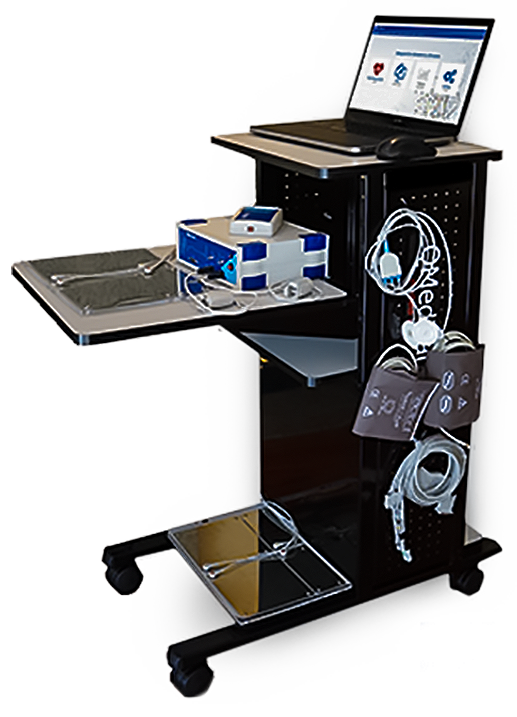
Innovation
VitalScan ANS PWV Pro®
VitalScan ANS PWV Pro is a non-invasive, fully automated computer-based system that provides Heart Rate Variability (HRV), blood pressure analysis and Pulsewave Velocity analysis for quantitative assessment of the Autonomic Nervous System (ANS).
Overstress and immobilization are conventional health risk factors, triggering the development of life threatening specific diseases. VitalScan ANS PWV Pro offers the possibility of Cumulative Physical and Mental Stress Assessment.
VitalScan ANS PWV Pro Pulse Wave Velocity (PWV) analysis is based on physiological phenomenon, observable and measurable in the arterial elasticity and stiffness during blood circulation.
VitalScan ANS PWV Pro is the result of more than three decades of very profound scientific research. Testing can be performed easily in almost all medical branches. VitalScan ANS PWV Pro offers the possibility to manage the effect of any health promoting strategy.
Solutions
ANS Assessment
(Autonomic Nervous System Testing)
The software and analyses are intuitive, easy-to-use and designed for success in the hands of both medical professionals and non-medical practitioners. Simple hardware and standard computer requirements ensure VitalScan ANS PWV Pro transitions seamlessly into virtually every health practice including clinics, laboratories, sports clubs and wellness centers.
VitalScan ANS PWV Pro products are easily applicable to the course of mass and periodical medical check-ups. Assessments can also be used for regular health control and for monitoring the effects of different treatment methods directed toward the general and specific health condition. Consequently, VitalScan ANS PWV Pro is useful for the prevention of high-professional and paraprofessional morbidity rates in different categories of workers and employees.
VitalScan ANS PWV Pro presents a quick and reliable assessment of basic health risk factors, such as the chronic vegetative misbalance, pathological disorders of the heartbeat activity, the levels of accumulated stress, and the decreased level of physical training.
VitalScan ANS PWV Pro uses cutting edge technology to enable precise measurements of parasympathetic and sympathetic activities in order to assess the autonomic balance in the body (evaluation of the autonomic nervous system’s regulatory function).
The VitalScan ANS PWV Pro system is used for objective evaluation and validation of various treatments, for research and documentation, and for evaluation of Autonomic Activity before and after a patient is affected by medication, physical treatment, stress, beta-blockers, or any other factor. The point of intersection is interpreted as the point of Autonomic Balance.
This method of assessment is applicable to many fields of clinical practice such as internal medicine, family practice, cardiology, endocrinology, gastroenterology, and psychotherapy. Heart Rate Variability and blood pressure analysis by VitalScan ANS PWV Pro serves as the basis for evaluating the patient’s ANS state before and after treatment, which can provide an accurate and reproducible assessment of treatment effectiveness.
The system is used to objectively confirm or exclude a Cardiovascular Autonomic Neuropathy (CAN), a Diabetic Autonomic Neuropathy (DAN) and other dysautonomia problems.
VitalScan ANS PWV Pro offers possibility of Accumulative Physical and Mental Stress Assessment. Overstress and immobilization are conventional health risk factors, triggering the development of life threatening specific diseases.
VitalScan ANS PWV Pro pulse wave is based on physiological phenomenon, observable and measurable in the arterial system during blood circulation. During one heart systole a certain blood volume is expelled. This propagates through the arteries due to the reciprocal transformation between kinetic energy of a segment of the expelled blood volume and the potential energy of a stretched segment of the resilient vascular wall. With VitalScan ANS PWV Pro, observations to changes in pressure, blood flow, velocity and profile throughout the whole pulse wave can be made for the clear classification of arterial elasticity.
Medical solutions
Autonomic Balance Analysis (ANS)
Heart Rate Variability (HRV) is a physiological function whereby the time interval between heart beats varies. These variations in heart rate reflect the quality of cardiovascular autonomic function. Autonomic function or function of the autonomic/visceral nervous system regulates involuntary action (e.g. respiration, digestion) of the intestines, heart, smooth muscle, and glands. This function is divided into two physiologically and anatomically distinct, mutually antagonistic subsystems: the sympathetic nervous system and the parasympathetic nervous system.
VitalScan ANS PWV Pro systems provide HRV testing which enable physicians to monitor the activity of both the sympathetic and parasympathetic branches of the autonomic nervous system (ANS) in order to accurately assess the state of a patient’s autonomic function.
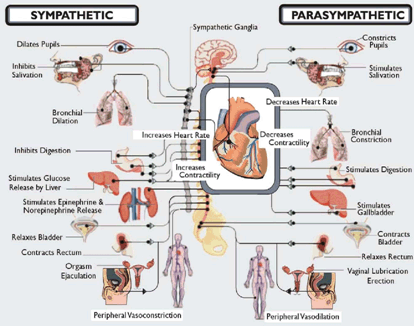
VitalScan ANS PWV provides a two-pronged approach to patient evaluation. Firstly, VitalScan ANS PWV Pro is able to detect specific types of autonomic dysfunction which can consequently be linked to a multitude of clinical diagnoses. Secondly, VitalScan ANS PWV Pro can be utilized for thorough, comprehensive assessments and physiological monitoring which provide physicians with a detailed and thorough patient appraisal which can often be overlooked in standard evaluations.
The wide range of clinical applications for VitalScan ANS PWV Pro makes it principally different from all other classes of diagnostic devices. VitalScan ANS PWV Pro allows the physician to thoroughly investigate modalities:
* Assessment of resting autonomic balance
* Assessment of reaction of the ANS on orthostatic intervention
* Assessment of autonomic reaction during Valsalva maneuver and deep breathing
* Sympathetic and Parasympathetic autonomic balance correction
Pulse Wave Velocity (PWV)

Pulse wave is a physiological phenomenon, observable and measurable in the arterial system during blood circulation. During one heart systole a certain blood volume is expelled. This propagates through the arteries due to the reciprocal transformation between kinetic energy of a segment of the expelled blood volume and the potential energy of a stretched segment of the resilient vascular wall. We can observe the changes in pressure, blood flow, velocity and profile throughout the whole pulse wave. It can be used for classification of the artery elasticity.
The condition of the small and large arteries is key to prevention and diagnosis of cardio-vascular related illness. In particular, the stiffness and augmentation of the major arteries is a strong indication of potential health problems including heart attacks, heart failure, sclerosis, and renal complications. PWV Analysis and arterial stiffness indexes (EEI, DDI and DEI) can suggest to healthcare professional to begin appropriate treatment long before the symptoms or clinical signs appear.
Age and systolic pressure strongly correlate with PWV. In fact, the most important factor contributing to increase in PWV is age because of increased arterial stiffness caused by medial calcification and loss of elasticity. The measurement of pulse wave velocity is useful in the study of the effects of aging, vascular diseases, vaso-dilating and vaso-constricting agents on arteries.
VitalScan ANS PWV Pro Pulse Wave Velocity measurement is a convenient method of quantifying arterial stiffness and augmentation. PWV provides invaluable insight into cardiovascular health, management of disease progression and monitoring the effects of medication, treatments, lifestyle and dietary habits.
Segmental Vascular Assessment
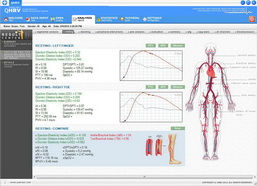
Initial assessment is the most vital step in managing a patient’s health. As such, extracting as much information and achieving a broad road map of the arterial anatomy is crucial for proper arterial and vascular assessment. VitalScan ANS PWV Pro Arterial Vascular Assessment measures blood pressure uses the identical standard as conventional arm cuffs. While the traditional arm cuff method just measures blood pressure, the VitalScan ANS PWV Pro Arterial Vascular Assessment is a powerful measure which provides further insight into arterial stiffness.
The information collected during the VitalScan ANS PWV Pro Arterial Vascular Assessment using the upper arm cuff is disseminated into a wide range of measurements. This data is then extrapolated into a number of indexes and further classifications which include the following:
• Arterial Stiffness Index (ASI)
• Blood Pressure (Brachial, Ankle)
• Pulse Pressure
• Pulse Rate
• Classification of Cardiovascular Condition
The information deduced from the VitalScan ANS PWV Pro Arterial Vascular Assessment is invaluable for detecting risk factors and facilitating the identification of patients who may be at risk for cardiovascular events. Studies have shown that the Arterial Stiffness Index (ASI) illustrates a strong correlation between the functioning and integrity of coronary arteries and atherosclerotic lesions. This particular connection is significant in that atherosclerotic lesions are fatal yet may remain asymptomatic for decades. Over 60 million Americans carry these life-threatening issues so isolating high-risk individuals is most valuable.
The indexes generated by the VitalScan ANS PWV Pro Arterial Vascular Assessment are far-reaching and provide important patient insight into a number of existing and potential health risks. These cardiovascular issues include the following:
• Atherosclerosis
• Infectious vasculitis
• Congenital abnormalities
• Hypertension
• Hyperlipoproteinemia
PAT (Peripheral Arterial Tone)
 Peripheral Arterial Tone (PAT) technology measures arterial tone changes in peripheral arterial beds. This information collected gives specialists important insight into the autonomic nervous system as well as the cardiovascular system. PAT technology is a noninvasive measure that is currently used to detect heart disease, erectile dysfunction and obstructive sleep apnea, however, it has also proven highly effective in the detection and monitoring of other cardiovascular conditions.
Peripheral Arterial Tone (PAT) technology measures arterial tone changes in peripheral arterial beds. This information collected gives specialists important insight into the autonomic nervous system as well as the cardiovascular system. PAT technology is a noninvasive measure that is currently used to detect heart disease, erectile dysfunction and obstructive sleep apnea, however, it has also proven highly effective in the detection and monitoring of other cardiovascular conditions.
As PAT data imparts early-stage information, PAT technology is highly valuable in disease detection and follow-up, thereby improving patient treatment and healthcare costs. In addition to detecting cardiovascular disease, the PAT system also presents potential for improving the diagnosis and management of other medical conditions including metabolic syndrome, diabetes, peripheral arterial disease and many others.
This module is for research use only.
Coronary Artery Respiratory Assessment (CRA)
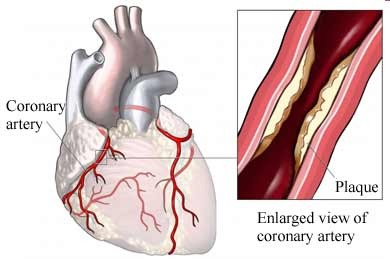 Coronary artery disease (CAD) occurs when the blood vessels that transport blood to the heart are narrowed and hardened due to plaque buildup (atherosclerosis). This narrowing compromises the flow of nutrient-rich, oxygenated blood to vital organs which can lead to stroke, heart attack and death. In fact, coronary artery disease is the leading cause of death among American adults. As such, detection are treatment are at the forefront of relevance.
Coronary artery disease (CAD) occurs when the blood vessels that transport blood to the heart are narrowed and hardened due to plaque buildup (atherosclerosis). This narrowing compromises the flow of nutrient-rich, oxygenated blood to vital organs which can lead to stroke, heart attack and death. In fact, coronary artery disease is the leading cause of death among American adults. As such, detection are treatment are at the forefront of relevance.
The photoplethysmograph (PPG) waveform has profound prognostic value for coronary artery disease. Studies show that fluctuations measured in photoplethysmograph (PPG) amplitude are directly related to coronary artery disease (CAD) and present powerful predictions of risk.
Photoplethysmograph (PPG) is measured using a non-invasive, radiation-free platform. This proprietary test system was developed by VitalScan ANS PWV Pro and utilizes a biosensor finger probe to collect data. The patient is then asked to perform a series of controlled breathing exercises. The coronary respiratory response (CRR) is derived from spectral analysis of the PPG signal during instructed breathing.
The PPG signal is automatically extracted and captured for processing. Using algorithms and analyzing software, a reading is produced which offers a timely and accurate diagnosis of Significant Coronary Artery Disease (S-CAD)
This module is for research use only.
Cumulative Stress Assessment
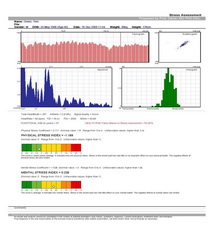 Stress means different things to different people. People recognize stress as a state of having too much expected of them, of being under pressure or strain, or of being barely able to cope with some external demand which is both excessive and prolonged. All of the symptoms carry the connotation of unreasonable demands being placed on the individual in an emotional, mental or psychological sense. A similar concept underlies the term stress in the medical sciences; a force exerted on a subject that, if not resisted, will damage or destroy it.
Stress means different things to different people. People recognize stress as a state of having too much expected of them, of being under pressure or strain, or of being barely able to cope with some external demand which is both excessive and prolonged. All of the symptoms carry the connotation of unreasonable demands being placed on the individual in an emotional, mental or psychological sense. A similar concept underlies the term stress in the medical sciences; a force exerted on a subject that, if not resisted, will damage or destroy it.
Stressors can be physical, mental or both. Physical stress is caused by long-term exposure to negative factors such as an irregular lifestyle, physical overload, environmental toxicity, cigarette/alcohol/drug use, improper diets, etc.
Mental stress can be caused by factors such as insecurity, negative emotions, mental overload, confusion, rejection on a social level, family problems, boredom, low self-esteem, etc.
Physical and mental stress each elicits physiological responses that are mediated through the autonomic nervous system. This autonomic nervous system (ANS) is both our major defense against stress and the system that demonstrates the principal symptomatic manifestation of stress in its early stages. The autonomic nervous system is conventionally divided into two parts in a yin/yang balance: the sympathetic, which activates organs, getting them ready to cope with exercise or other physical stress; and the parasympathetic, which controls background “housekeeping” functions in the body. The balance between these two systems is an indicator of the body’s reaction to external and internal demands.
Cardiovascular Fitness Test
 It is widely recognized that Orthostatic testing is one of the most effective methods of measuring subtle changes in cardiovascular function, particularly the system’s regulatory mechanisms. When performing the Orthostatic test, the patient sits down for several minutes resting peacefully and then stands up. When the body position shifts from supine or seated to standing, specific changes in heart rate and blood pressure occur as a compensatory reaction of the body. Testing helps to assess the ability of both sympathetic and parasympathetic nervous systems to adequately respond to regulatory challenge caused by gravitational shift in the body’s blood mass. The test result (i.e. the orthostatic heart rate) is the difference between the heart rates at supine rest and at standing position.
It is widely recognized that Orthostatic testing is one of the most effective methods of measuring subtle changes in cardiovascular function, particularly the system’s regulatory mechanisms. When performing the Orthostatic test, the patient sits down for several minutes resting peacefully and then stands up. When the body position shifts from supine or seated to standing, specific changes in heart rate and blood pressure occur as a compensatory reaction of the body. Testing helps to assess the ability of both sympathetic and parasympathetic nervous systems to adequately respond to regulatory challenge caused by gravitational shift in the body’s blood mass. The test result (i.e. the orthostatic heart rate) is the difference between the heart rates at supine rest and at standing position.
For a healthy individual, standing up as well as maintaining the standing posture for several minutes causes no significant physical exertion. However, if there is subtle cardiovascular deficiency or the functional capacity of the body’s regulatory mechanisms is inadequate then this maneuver becomes a significant stressor to the body.
VitalScan ANS PWV Pro Orthostatic testing is the quantitative and qualitative assessment of the fitness and health levels based on HRV analysis. The test is quick and effective and begins with the attachment of simple, noninvasive electrodes, attached as instructed. The candidate is instructed to stand for two minutes followed by sitting for 30 seconds followed by standing for 30 seconds. The full process is repeated alternately for three minutes. The data collected from mean cardio tachogram and spectrum is analyzed to produce eventual results in both quantitative and qualitative format.
This module is for research use only.
ECG Analysis
 Electrocardiography (ECG) is an interpretation of the electrical activity of the heart over time as collected from a patient during the procedural test. Modern ECG devices use sophisticated techniques like amplification, filtering, and signal analysis to accurately and conveniently measure, display, and analyze ECG data. ECG is the most important test for interpretation of cardiac rhythm, conduction system abnormalities, and for the detection of myocardial ischemia.
Electrocardiography (ECG) is an interpretation of the electrical activity of the heart over time as collected from a patient during the procedural test. Modern ECG devices use sophisticated techniques like amplification, filtering, and signal analysis to accurately and conveniently measure, display, and analyze ECG data. ECG is the most important test for interpretation of cardiac rhythm, conduction system abnormalities, and for the detection of myocardial ischemia.
Arrhythmic cardiac events, which may be extrasystoles (i.e. cardiac premature heart beats) are early warning signs for serious potential cardiac issues. The relation between supraventricular or ventricular extrasystoles and health risk is important because they can precede myocardial infarction. They are an early warning signal for possible cardiac problems as myocardial ischaemia ( a decreased oxygen supply to cardiac myofibers or different kinds of cardiomyopathy). Cardiomyopath is a disease or disorder of the heart muscle which can result from numerous conditions including congenital defects, acute or chronic infections, coronary artery disease, drugs and toxins, metabolic disorders, connective tissue disorders, or nutritional deficiencies.
Exercise ECG Assessment
VitalScan ANS PWV Pro’s Exercise ECG is an all-inclusive, PC-based electrocardiogram testing system equipped with state-of-the-art technology for performing stress tests of the utmost accuracy. This low-cost, easy-to-use system enables users to simultaneously monitor 12 leads onscreen using programmable reports and protocols. Other highlights and benefits of VitalScan ANS PWV Pro’s Exercise ECG include the following:
• Utilizes wireless ECG sensors
• Automatically generates and prints reports
• Produces bit-to-bit blood pressure measurements
• Customizable stress protocols based on personal preference
• Produces all standard stress protocols
• Generates ST measurements for modification before, during or following completion of the test
A stress test, otherwise known as an exercise electrocardiogram, is a screening tool used to evaluate the effect of exercise on your heart and lungs. Because some heart issues only become apparent during exercise, the test utilizes a treadmill or stationary bicycle to produce results that can be tracked and measured. This noninvasive, diagnostic test measures your heart rate, blood pressure and electrocardiogram (or heart’s electrical activity) before, during and after exercise. The level of exertion is increased gradually during the test to ascertain whether or not the heart and lungs are receiving enough oxygen and performing properly.
Overall Health Assessment
Establishing overall health level is key to disease prevention and optimized health. VitalScan ANS PWV Pro presents a systematic and convenient approach to calculating individual overall health. By combining the results of all VitalScan ANS PWV Procedural tests including the data collected from Pulse Wave Velocity assessment, ECG analysis, Autonomic Nervous System assessment, cumulative stress testing, fitness testing and correlation analysis a value for overall health is determined.
VitalScan ANS PWV Pro analyzes the potential for health problems by examining the body of data generated by thorough testing as compared to a database of over 50,000 test subjects. The resulting value is measured in a percentage of overall health risk with 50% relating to ‘normal’. A value of over 50% is cause for concern and necessitates medical intervention. The value can be useful in understanding current physical state as well as recognizing resource depletion and reserves available for coping with future ailments.
Studies indicate that individuals with increased health risk are more prone to develop illness, including life-threatening disease, within the following few years of assessment. Determining overall health and risk of disease development is, therefore, vitally important to the prevention of serious illness and an important contribution to the wellbeing and longevity of individual life. Patients are able to address their current health issues and manage risks accordingly in order to improve overall health.
VitalScan ANS PWV Products provide the depth and breadth of information required to make informed decisions regarding therapy, treatment and important lifestyle changes. Products are professional medical solutions suitable for mass testing in a cost-effective manner. The value of VitalScan ANS PWV Pro analyses and health testing cannot be overstated as preventative tools and supplementary guides to overall patient health.
Exercise ECG Assessment
 Heart rate variability (HRV) is a measure of variations in the heart rate. It is usually calculated by analyzing the time series of beat-to-beat intervals from ECG or arterial pressure tracings.
Heart rate variability (HRV) is a measure of variations in the heart rate. It is usually calculated by analyzing the time series of beat-to-beat intervals from ECG or arterial pressure tracings.
Various measures of heart rate variability have been proposed, which can roughly be subdivided into time domain, frequency domain and non-linear measures. HRV is regarded as an indicator of the activity of autonomic regulation of circulatory function. It also regarded as the definitive method of analyzing the activity of the autonomic nervous system. Alteration (mostly reduction) of HRV has been reported to be associated with various pathologic conditions like hypertension, hemorrhagic shock, and septic shock. It has found its role as a predictor of mortality after an acute myocardial infarction.
Time Domain
A simple example of a time domain measure is the calculation of the standard deviation of beat-to-beat intervals. Other time domain measures include root mean square of the differences between heart beats (rMSSD), NN50 or the number of normal to normal complexes that fall within 50 milliseconds, and pNN50 or the percentage of total number beats that fall with 50 milliseconds. SDNN has been strongly corelated to overall variability, while rMSSD relates to the parasympathetic nervous system activity on heart rate.
Frequency Domain
A common frequency domain method is the application of the discrete Fourier transform also known as the Fast Fourier transform, to the beat-to-beat interval time series. That expresses the amount of variation for different frequencies. Several frequency bands of interest have been defined in humans.
Overall Health Assessment
Establishing overall health level is key to disease prevention and optimized health. VitalScan ANS PWV Pro presents a systematic and convenient approach to calculating individual overall health. By combining the results of all VitalScan ANS PWV Procedural tests including the data collected from Pulse Wave Velocity assessment, ECG analysis, Autonomic Nervous System assessment, cumulative stress testing, fitness testing and correlation analysis a value for overall health is determined.
VitalScan ANS PWV Pro analyzes the potential for health problems by examining the body of data generated by thorough testing as compared to a database of over 50,000 test subjects. The resulting value is measured in a percentage of overall health risk with 50% relating to ‘normal’. A value of over 50% is cause for concern and necessitates medical intervention. The value can be useful in understanding current physical state as well as recognizing resource depletion and reserves available for coping with future ailments.
Studies indicate that individuals with increased health risk are more prone to develop illness, including life-threatening disease, within the following few years of assessment. Determining overall health and risk of disease development is, therefore, vitally important to the prevention of serious illness and an important contribution to the wellbeing and longevity of individual life. Patients are able to address their current health issues and manage risks accordingly in order to improve overall health.
VitalScan ANS PWV Products provide the depth and breadth of information required to make informed decisions regarding therapy, treatment and important lifestyle changes. Products are professional medical solutions suitable for mass testing in a cost-effective manner. The value of VitalScan ANS PWV Pro analyses and health testing cannot be overstated as preventative tools and supplementary guides to overall patient health.

Innovation
VitalScan ANS PWV Pro®
The VitalScan ANS PWV Pro System is a clinically powerful and easy to use non-invasive system to test for hidden diseases. In 15 minutes identify clinical autonomic disorders and uncover major illness and health risks including:
* Sudden Death
* Silent Heart Attack
* Syncope
* Hypertension
* Cardiac Autonomic Neuropathy (CAN)
* Diabetic Autonomic Neuropathy (DAN)
* Vascular Abnormalities
* Orthostatic Hypotension
* Other Hidden Diseases
Testing of the autonomic nervous system is a is a recommended standard of care by the American Diabetes Association for patients with Type 1 and Type 2 diabetes.
Features and Benefits:
Easily adaptable towards general and specific requirements of almost all medical branches.
* Presents a quick and reliable supplementary assessment of basic health risk factors.
* Assesses the balance between the activities of the sympathetic and parasympathetic branches of the autonomic nervous system.
* Reliably discovers ventricular and superventricular extra systoles.
* Assesses accumulated physical and mental stress.
* Assesses physical training needs based upon an individual’s personal fitness levels.
* Reveals development of possible health risks.
* Provides early indications of health risks for quick detection and prevention of illness, disease, and progressive stress conditions before onset and development.
* Efficiently screen mass population to detect potential risks and reserve costly, full medical checkups for only those exhibiting health threats.
* Arterial Vascular Assessment
* Ankle-Brachial Index (ABI)
* Comprehensive Autonomic Balance Analysis (ANS)
* Cardiovascular Fitness
* Cumulative Mental and Physical Stress
* Pulse Wave Velocity
* Augmentation Index (AI)
* Reflection Index (RI)
* Stiffness Index (SI)
* Peripheral Arterial Tone Assessment (PAT)
* Endothelial Dysfunction
* ECG Analysis
* Heart Rate Variability Analysis (HRV)
* Neurovegetative Analysis with custom measurement marks
* Cardiovascular Health Analysis
* Baroreceptor Sensitivity Analysis
* Full compliance to the Standards of HRV professional analysis
* View progress charts of unlimited sessions
* Functional Age
* Patient History Progress Reports
* Statistical Analysis
* Normative database included based on more than 50 000 assessments
* HRV data comparison to the population norms
* Automatically evaluates quality of data recorded to ensure accuracy of results
* Automatic artifact detection and visual data editing
* Easy-to-read interpretation of the autonomic balance status
* Supports both pulse wave sensor and ECG recorders
* Trains for stress reduction and better inner balance
* Easy-to-use intuitive colorful graphical user interface
* Backed by 30 years of documented medical studies
* Easy software installation and automatic hardware detection
* HRV data export into Microsoft Excel spreadsheet and ASCII text formats
* Supported Languages: English, Spanish, Italian, German, Chinese, Japanese, French
Recommended for:
* Clinical Researchers
* Stress Management Counselors
* Alternative Therapy Specialists
* Biofeedback Therapists
* Physiology Class Teachers
* Physical Occupational Recreational Therapists
* Cardiovascular Rehabilitation Specialists
* Professional Psychologists
Standard Compliance
* VitalScan ANS PWV Pro software was developed according to the standards and mathematical procedures for short-term HRV analysis set forth by:
– The European Society of Cardiology
– The North American Society of Pacing and Electrophysiology
* VitalScan ANS PWV Pro is an FDA 510k cleared product. Please contact your local sale representative for more detail information. Some testing modules in the US version may not be available or may be available for research purpose only.
* VitalScan ANS PWV Pro also compliance with the following standards:
EN ISO 13485:2003, EN 60601-1:1990, EN 60601-1-1:2001, EN 60601-1-2:2001, ANSI-AAMI EC57-98, ANSI-AAMI EC13:2002, EMC, Directive 93/42/EEC, CE 0120
Minimum Computer Requirements
* CPU 2 GHz (or equivalent)
* 4 GB of RAM
* Video card with at least 1024×768 and High-Color resolution
* 4 GB of free hard disk space
* One available USB port, version 1.1 or higher
* Windows 7/8/10 Operating system

